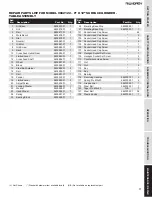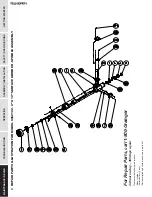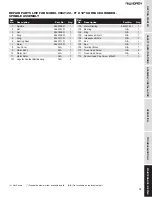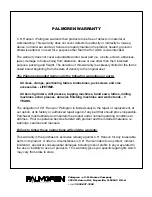
MAINTENANCE / REP
AIR
TROUBLESHOOTING
OPERA
TION
ASSEMBL
Y / INST
ALLA
TION
SAFETY
/ SPECIFICA
TIONS
GETTING ST
ARTED
8
OPERATION
Make sure unit is off and disconnected
from its power source before attaching
any components, servicing or maintenance being made on
the machine.
Always wear safety glasses complying
with U.S. ANSI Z87.1 before beginning any
power tool operation.
The machine’s functional parts
To properly operate the Model 9682122 Surface Grinder, you
must familiarize yourself with all of the machine’s controls.
3
4
5
6
8
7
1
2
1. Vertical down feed handwheel
2. Vertical measurement scale
3. Spark shield
4. Table dog end stop dogs (end stop on right not shown)
5. Table travel handwheel - X-axis (left and right)
6. Table cross feed handwheel - Z-axis (in and out)
7. Cabinet base (optional 9670109)
8. Spindle start/stop buttons
* Shown with optional Magnetic Chuck 9682130
Turning on the surface grinding machine
A
• The on/off buttons (A) are located on the right side of the
machine.
• Push the on button to start the machine and the off button to
stop the machine.
OPERATION - TABLE AND GRINDING HEAD
MOVEMENT
Chuck travel X-axis (left and right)
• The table X-axis
handwheel (B)
is located on the
lower left side of
the machine. The
handwheel and
moves the chuck
left and right by
rack and pinion
gearing
• Clockwise rotation
of the handle feeds
the table to the right, counterclockwise rotation feeds the
table to the left.
• The distance moved by the handwheel can be read on the
inside measurement ring (C). The ring can be set to zero
(0.00) for a reference point before an operation is undertaken
• The left / right distance of the table travel is set by the table
end dog stops. The table will stop its travel based on their
positions.
Chuck travel Z-axis (in and out)
• The table Z-axis
handwheel (D)
is located on the
lower right side of
the machine. The
handwheel and
moves the chuck
and out.
• Clockwise rotation
of the handle feeds
the chuck in and
counterclockwise
rotation out.
• The handwheel can be locked into position by tightening up
the locking knob (E).
B
C
D
E






































